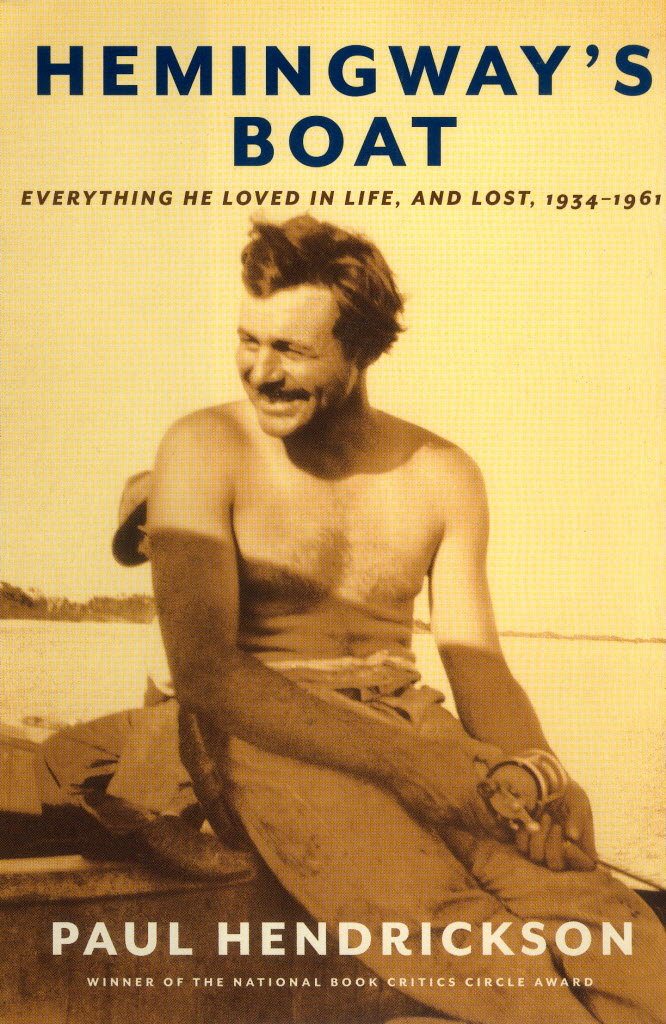Each day leading up to the March 8 announcement of the 2011 NBCC award winners, Critical Mass highlights one of the thirty finalists. Today, NBCC board member Steven G. Kellman discusses #2,”Hemingway’s Boat: Everything He Loved in Life and Lost, 1934-1961” by Paul Hendrickson (Knopf). More in this series here.

The outsized life of Ernest Hemingway – enigmatically wounded in World War I; expatriate in Paris; author of In Our Time, The Sun Also Rises, A Farewell to Arms, and much else; boxer; bullfight aficionado; big-game hunter; deep-sea fisherman; marriage recidivist; Nobel laureate; suicide – constitutes one of the enduring fables of American literary history. Like Norman Mailer, Walt Whitman, and Jack London, Hemingway was a master at creating his own myth. That myth has captivated chroniclers of all sorts, and anyone who presumes to biographize Hemingway must contend with Carlos Baker, A. E. Hotchner, Kenneth S. Lynn, James Mellow, Jeffrey Meyers, and Michael S. Reynolds, among others. Sailing into what he calls “the vast, roily, envy-ridden sea of Hemingway studies,” Paul Hendrickson adopts as his principle of navigation a concept borrowed from astronomy – averted vision.
“The idea,” he explains, “is that sometimes you can see the essence of a thing more clearly if you’re not looking at it directly.” Looking at the Pilar, the custom-built, 38-foot fishing vessel that Hemingway owned from 1934 until his death in 1961, Hendrickson is able to see things about its skipper not readily apparent from shore. His book is a triumph of biography as metonymy.
Soon after returning from East Africa in 1934, Hemingway bought a twin-cabin cruiser, named it Pilar, and docked it near his home in Key West and his finca in Cuba. He delighted in piloting it through the Caribbean in quest of marlin, the majestic species whose population he became adept at depleting. Hendrickson provides detailed information about seaworthy craft and the craft of catching aquatic creatures. He evokes raffish Key West and pre-Castro Cuba. But the strength of the book lies in the way it weaves in stories not only about 27 turbulent years in which the Pilar was Hemingway’s passion but also about many of the visitors whom Papa invited aboard during the time he was its gregarious but often abusive skipper. They include some whom Hendrickson, drawing on letters, interviews, and a ship’s log, retrieves from obscurity. Particularly memorable are three mini-biographies embedded within the overall account of a troubled, ailing literary heavyweight struggling to stay afloat.
Arnold Samuelson was a 22-year-old aspiring writer who hopped a freight from Minnesota and made his way to the Maestro’s door. Hemingway took an immediate liking to him and employed him as factotum. Hendrickson follows Samuelson through an unconventional life haunted by a fatalism similar to his mentor’s. Also taking a solo turn is Gregory “Gigi” Hemingway, the third of the writer’s three sons, who became a physician but continued to disappoint his legendary father. A transvestite who underwent an incomplete sex-change operation at 63, he shared his father’s discomfort with gender identity. The most endearing character is Walter Houk, whom Hendrickson befriended in California as the octogenarian was experiencing the onset of Alzheimer’s. Despite fading memory, Houk vividly recalls how, serving in the American embassy in Havana, he met Nita Jensen, Hemingway’s secretary, and married her in the novelist’s house. Hendrickson traces Houk’s career as diplomat, travel writer, and painter, and, sounding again the theme of biography as metonymy, sees in this wistful old man “the story of all the rest of us.”
Hemingway was a sedulous slacker who loafed and invited his soul and, by doing so, was able to compose consummately concentrated prose. Hendrickson likens his style of writing to the way he caught marlin: “The art of slacking, of holding back before you try to set the hook, is counterintuitive, counterreflexive, which is probably why Hemingway was so damn good at it – in both fishing and literature.” Through its diversions and digressions, Hemingway’s Boat follows a similar method of slacking.
“The most essential gift for a good writer,” Hemingway wrote, “is a built-in, shock-proof shit detector.” Few biographers, few writers of any sort, possess that gift. Nevertheless, without trying to mimic Hemingway, Hendrickson offers a few true sentences of his own. His account of a fishing trip with Patrick Hemingway might stand, synecdochically, for the brilliance of his writing: “In the gathering dark of that mid-June 1987 evening, the water seemed to lie around us like glass. We stood about fifteen yards apart. Fat, pulpy rainbows began rising to our casts. You couldn’t quite see them but you could hear them sipping and slurping and breaking the water. Patrick worked his rod like a wand, sending his line in great noiseless loops far out onto the stream. We fished for about an hour and barely spoke.” With its narrative economy, attention to detail, and respect for the rhythm of a sentence, Hendrickson’s prose poetry is worthy of its subject.
Here are interviews with Paul Hendrickson:
http://www.npr.org/2011/10/02/140849263/the-man-and-the-boat-hemingway-aboard-the-pilar
http://www.salon.com/2011/09/18/hemingway_s_boat/
And here are some reviews of his book:
http://online.wsj.com/article/SB10001424053111904060604576572741010152296.html
http://www.nybooks.com/articles/archives/2011/oct/13/finest-life-you-ever-saw/?pagination=false
http://www.chicagotribune.com/entertainment/books/ct-books-hemingways-boat-review,0,3285433.story
http://bnreview.barnesandnoble.com/t5/In-the-Margin/Hemingway-s-Boat/ba-p/5667
http://www.csmonitor.com/Books/Book-Reviews/2011/0916/Hemingway-s-Boat
http://www.guardian.co.uk/books/2012/jan/08/ernest-hemingway-boat-hendrickson-review
http://www.cleveland.com/books/index.ssf/2011/09/in_hemingways_boat_paul_hendri.html

